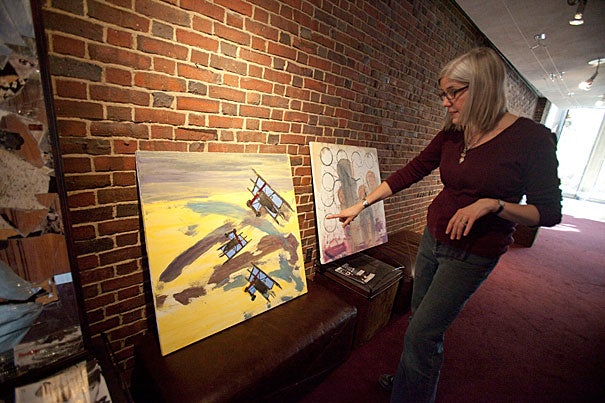
“I wanted the audience to know that they are entering into a different universe,” said one of the show’s writers and producers, Ruth Bauer, of the installation that has transformed the center’s hallway and lobby into a mini modern museum.
Brooks Canaday/Harvard Staff Photographer
Students go Dada over project
Their creations grace Loeb lobby as backdrop to ‘Blue Flower’
In one painting, the black outline of a half–hidden, skirted figure crosses the pink line of a stage as an audience member looks on. Nearby, ghostly, skeletal X-rays hang side by side. Around the corner, a plaster cast of a human head is nestled in a shoe atop some stacked stools.
The mysterious and evocative artworks greet visitors en route to the American Repertory Theater’s (A.R.T.) Loeb Drama Center main stage for the world premiere of its newest production, “The Blue Flower.”
“I wanted the audience to know that they are entering into a different universe,” said one of the show’s writers, Ruth Bauer, of the installation that has transformed the theater’s hallway and lobby into a mini modern museum.
The curious pieces, many created by Harvard undergraduates as well as cast members of “The Blue Flower,” mimic the iconography of the avant-garde musical’s themes of love, friendship, war, and Dadaism.
The installation is the result of a collaboration between Bauer and several Harvard students and is supported by the Peter Ivers Visiting Artist Fund through Learning From Performers, a program of the Office for the Arts at Harvard. It is one of many joint efforts between the A.R.T. and University students in recent years, and one that adheres to the theater’s new mission to broadly engage with the University community.
“While the A.R.T. has always worked closely with undergraduates, under Diane Paulus’ leadership that commitment has intensified,” said A.R.T. dramaturg Ryan McKittrick, who helped coordinate the art project.
Several undergraduates with concentrations like art history, philosophy, music, and film regularly joined Bauer over two months in the Adams Artspace, a converted squash court in the Harvard House, to paint, glue, staple, hammer, and weave together their creations.
Paulus ’88 took over as artistic director in 2008 and promptly announced her desire to “expand the boundaries of theater,” in part by staging inventive new works and modern versions of classics, but also by working directly with students.
“Diane Paulus was interested in ‘The Blue Flower’ … and asked me if I would be interested in working with the students because of the varied academic connections we could make,” said Bauer, who jumped at the chance to create a Dada-inspired environment modeled on her play.
Bauer’s characters are loosely based on German artists Hannah Höch, Max Beckmann, Franz Marc, and French physicist Marie Curie, and the musical unfolds against the backdrop of World War I and the rise of the Weimar Republic, and the cultural movement known as Dadaism.
To inspire the students’ creativity and inform their works, Bauer also helped coordinate a trip to the Harvard Art Museums’ off-site facility to view works by Dada artists from the museum’s collection.
Senior Sonia Coman adhered to the Dada principle of ambiguous dimensional realms when creating her painting of the half-obscured figure walking onstage.
Coman, an art history concentrator who has a secondary field in studio art, said that Bauer’s enthusiasm “fueled the student involvement” with the project and that the flexible use of the space in Adams House inspired “the unfolding of inspiration.”
Other joint A.R.T. and student initiatives include courses for undergraduates, like last fall’s “Theater, Dream, Shakespeare,” co-taught by Paulus and Marjorie Garber, the William R. Kenan Jr. Professor of English and of Visual and Environmental Studies. For the second year, the A.R.T. is offering a program for undergraduates in January, this year in collaboration with the Liz Lerman Dance Exchange, as part of the January intensives supported by the president’s arts initiative.
Students also can apply for the observership program, a longtime collaboration between the Harvard-Radcliffe Drama Club and the A.R.T. in which Harvard undergraduates sit in on rehearsals of A.R.T. productions.
“Offering students the opportunity to engage with working professionals and to see how professional theater is created is a crucial part of the A.R.T. mission, and we are thrilled to have them as part of the creative process,” said McKittrick.
“It was an antidote to the heady stuff they are doing and an element in their lives that creates some balance,” said Bauer, who called the group “delightful.”
Bauer let them freely experiment with the varied bits of ephemera she collected for the project, junk like chicken wire and old film reels, salvaged from the trash or discovered at yard sales, to make their Dada-themed creations. But at one point she had to draw the line.
“The students got really excited and wanted to construct a trench in the Loeb Drama entry space, which would have been a great way to enter the theater,” said Bauer. But due to space constraints, “Unfortunately, that plan was nixed.”




